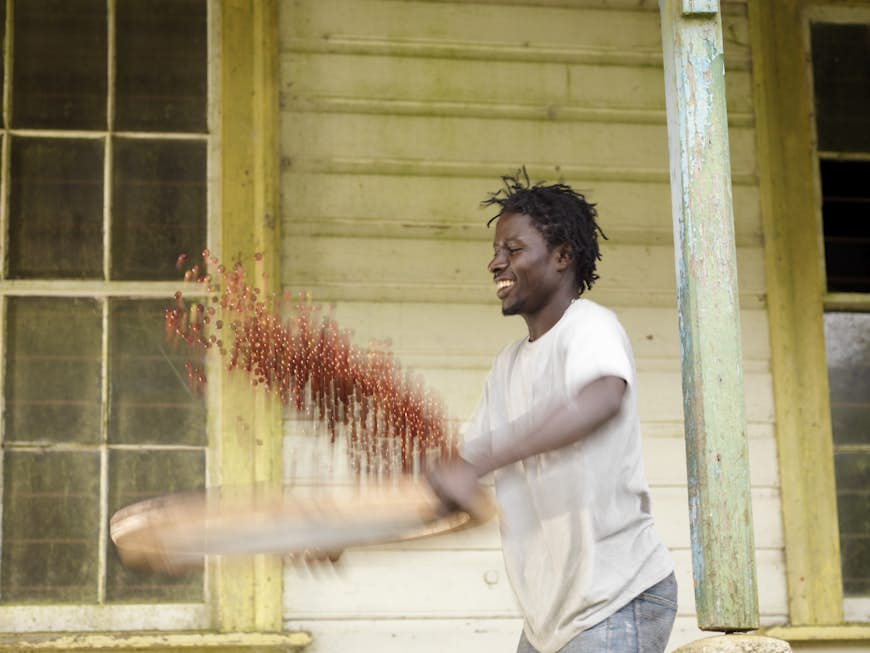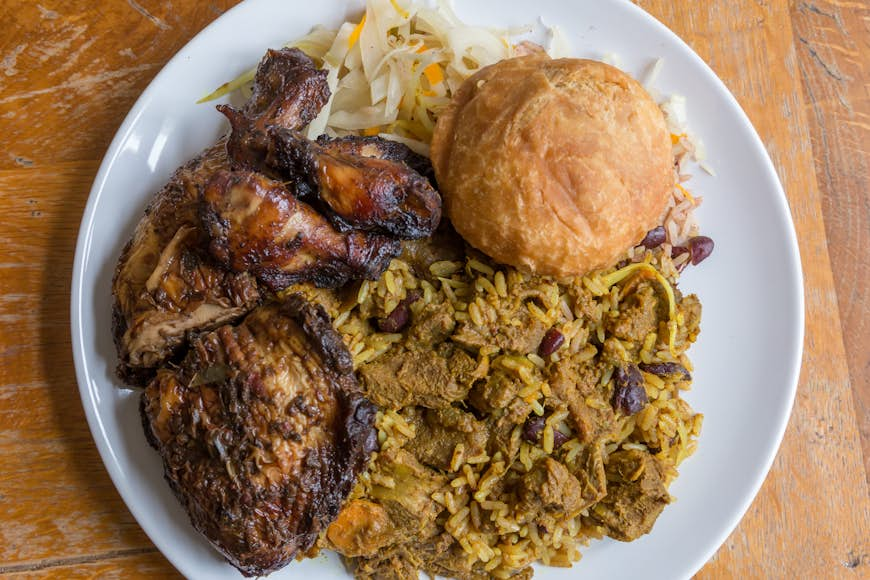Jamaican food is as distinctive as the music that the island is famous for, and its hot Caribbean flavors have proved almost as world-conquering as reggae and dancehall. The indigenous fruits of the tropics, the island’s complicated history of colonialism and the trade of enslaved people, all make for a distinctive combination of influences that are reflected in the nation’s palate.
Whether it’s ackee and saltfish for breakfast, curried goat for lunch, or an I-tal vegetarian dinner, tucking into the local cuisine will teach you more about Jamaica than a month at any all-inclusive resort. Here are the best things to eat and drink in Jamaica.
Eat a breakfast of champions
Any good day on holiday starts with a proper breakfast, and with ackee and saltfish, Jamaica has one of the best. Ackee is a lychee-like fruit that grows across the island, with the sneaky trick of being quite toxic until it’s properly ripe. It’s rather bland on its own, so for this classic dish, it’s cooked down with saltfish to add savory depth. Sautéed onion, tomato and scotch bonnet peppers are stirred through for some punch, then served up with a side of breadfruit, plantain or johnny cakes (dumplings).
To some, ackee and saltfish bear an uncanny resemblance to scrambled eggs, but it’s a meal that speaks deeply to the island’s violent past. The British colonizers introduced both the main ingredients to Jamaica – ackee trees from West Africa and preserved dried saltfish from the north Atlantic – as cheap foods for the enslaved people laboring on the plantations.
Where to try it: Any hotel worth their salt in Jamaica should include ackee and saltfish as a breakfast option, but Hot Pot in Kingston is typical of the small local restaurants that serve it up every morning – visit on Sunday to enjoy it as part of a Sunday brunch buffet.
Grab a taste of jerk
The mouth-tingling spicy taste of jerk is one of Jamaica’s favorite (and most famous) dishes. The name describes the method of ‘jerking’ meat – covering it with a tongue-searing marinade and spice rub and then slowly smoking it over a fire of pimento wood that imparts its own special flavor to the food. Allspice, a dark berry that tastes like a mixture of cinnamon, clove and nutmeg, is the backbone of every blend.
Boston Bay on the north coast is Jamaica’s traditional home of jerk and roadside barbecue stands line the entrance to the town. Chicken, pork and sausage are the most popular meats to jerk, and are served up with a side of bread-kind – a catch-all term for a starch accompaniment such as roast breadfruit, plantain, festival (sweet fried cornbread) or bammy (fried cassava bread).
Jerk is a method of cooking taken from the maroons – the communities of Africans who liberated themselves from enslavement in the 18th century and successfully fought several wars to maintain their freedom. Maroons would smoke wild-caught meat to preserve it and then sell it at local markets.
Where to try it: If you can’t make it to Boston Bay, Scotchies just outside Ocho Rios is one of the best jerk restaurants in Jamaica (there’s a branch in Montego Bay as well).
When it comes to curry goat, some like it hot
Indentured Indian workers brought to the Caribbean by the British in the 19th century carried with them what would become one of Jamaica’s favorite dishes: curry. Jamaicans added their own twist by adding allspice and thyme to create a Caribbean classic. Curry goat is the dish to try here, where the meat is simply chopped up, bones and all, and cooked down to succulence in an oily turmeric-yellow curry sauce, rich in onions and garlic. A smooth glug of coconut milk balances out of kick of the scotch bonnet peppers.
That hot pepper bite is also on display with escovitch, a marinade of vinegar, onions, garlic, carrots and scotch bonnet, typically used on seafood. Escovitch fish is a national favorite, served up in high-class Kingston restaurants and cheap beach bars alike.
If you prefer slow-cooked meat without so much heat, we’d point you towards the tangy flavors of brown stew (typically made with chicken or fish) or the always unctuous oxtail, something of a national obsession that gently simmers for hours with tomato, thyme, garlic and butter beans. Whichever option you go for, these will all be served with a big helping of rice and peas.
Where to try it: For homely Jamaican curries and stews, it’s often best to just follow your nose: the most unassuming places are often the best. In Negril, Erica’s Hideaway is one of our favorites.

Patties to go
Sometimes you just want food on the go that you can eat with your hands. For this look no further than the humble Jamaican patty. These folded half-moons of golden pastry come with a variety of fillings, including beef, curry chicken, fish, and vegetable with cheese.
You’re never too far from a patty shop, but the two most popular national chains in Jamaica are Juici Patties and Tastee Patty, which sell a whole variety of great takeaway options, including fish tea – a delicious broth that’s a perfect pick-me-up. If you’re after something fancier, posh patties are also available.
Where to try it: Devon House Bakery in Uptown Kingston will even sell you a lobster patty, then send you next door for a dark Jamaican stout ice cream.
Vegetarians and vegans
Thanks to the Rastafari, Jamaica is vegetarian-friendly. The I-tal diet (derived from ‘vital’) has evolved an endless index of ingredients to be excluded from the diet, including no meat or dairy (the latter is “white blood”) and no artificial chemicals, along with no alcohol, cigarettes or drugs (ganja doesn’t count).
Fruits, vegetables, soy, wheat gluten, and herbs prevail. It’s a diet that has continued to grow in popularity, and many restaurants offer I-tal options on their menus. Popular dishes include eggplant curry, whipped sweet potatoes and steamed vegetables, and pizzas made with nut bread for the base and topped with ackee “cheese”.
Where to try it: One of the best places to eat I-tal is at Stush in the Bush, a farm-to-table restaurant near Ocho Rios, which offers set courses of delicious seasonal vegetarian food as well as an Earth Walk around the beautiful hilltop farm where the produce is grown.
Drink rum, the national tipple
Rum is surely Jamaica’s national drink. The biggest distillery is Wray & Nephew, which owns the oldest continually producing sugar and rum estate in the country at Appleton – it has been in operation since the 1740s.
The dark rum Appleton is its marquee brand and you can take tours of the estate where it’s made. Alternatively, pick out the distinctive green and yellow label of the white overproof rum – a potent drink that can easily knock down the unprepared. To go easy, try it with the local grapefruit soda for a rum and Ting mixer (rum and ginger beer is also popular), or just a simple frosty Red Stripe lager.
A lighter alternative is sorrel, an iced tea with a hint of ginger made from infused hibiscus flowers – if you can’t get it fresh you can buy it in the cold cabinet of any grocery store. On the road, look out for fresh coconut straight from the nut from streetside vendors, along with its white ‘jelly.’
Where to try it: Any beach bar in Jamaica will serve you a shot of rum with a side order of reggae, but if you want the best sounds and the best view to go with your drink, head to Dub Club on a Sunday night, for the twinkling lights of Kingston and the deepest dub and reggae cuts.

Wake up and smell the coffee
Jamaica is also a coffee-growing country and you can take tours of the coffee estates in the Blue Mountains, where the most valuable bushes are grown. The rich arabica coffee they produce isn’t cheap, but a bag from a local store makes a great souvenir from your trip, allowing you to keep enjoying the tastes of Jamaica even when you’ve returned home.
Where to try it: Take a bean-to-cup tour of Craighton Coffee Estate to sip a taste of the Blue Mountains on the slopes where the coffee is grown.
